If someone steals your wallet, you’d notice. If your car disappears, you’d definitely notice. Even if someone swipes your lunch from the office fridge, there’s going to be drama.
But stealing electricity? That sounds bizarre, right? After all, electricity is invisible, weightless, and doesn’t sit in your pocket. How can you steal something you can’t even see?
And yet—it happens. A lot.
Because electricity is intangible, some people think taking it without paying isn’t “real” theft. No broken windows, no missing objects—just a little extra juice flowing where it shouldn’t.
But make no mistake: electricity theft is very real!
Despite being invisible, electricity has a price. And when people steal it—whether by tapping into power lines, tampering with meters, or setting up illegal connections—the cost doesn’t just vanish. It gets passed on to those who do pay their bills (a.k.a. YOU).
Electricity theft isn’t a “victimless crime.” It’s an invisible problem with very real consequences. So let’s shed some light on the dark side of stolen power!
Welcome to 1000whats, where we expose the shocking truth about electricity theft, spark curiosity, and jolt you with facts—because stolen power isn’t just current events, it’s charged with consequences!
What is electricity theft?
Simply put, electricity theft is stealing power—literally. No need for a ski mask or getaway car, just some sneaky wires and bad decisions. It’s an umbrella term for all the creative (and illegal) ways people tap into the grid without paying a dime.
And it’s not just a quirky crime in some dark alley—it’s a global headache. According to the Bidgely, electricity theft drains over $100 billion from the global economy every year. That’s billion with a B. Imagine what we could do with that money—like fund free coffee for life or invent self-cleaning laundry. But nope, it’s gone. Zapped away.
But wait, it gets worse! This isn’t just about money. Electricity theft causes overloaded power lines, blackouts, and sometimes even deadly accidents. Plus, it fuels corruption and weakens infrastructure.
The oldest trick in the (power) book
Now, you’d think electricity theft started when electricity became common. Nope. Believe it or not, as soon as humans figured out how to make light bulbs glow, someone else figured out how to steal that glow.
Check out the Daily Yellowstone Journal from March 27, 1886. There’s an actual report about “power pilfers” (fancy term for electricity thieves) tapping into Edison’s electricity in New York. Yes—1886! That’s back when people still thought dinosaurs were a government conspiracy. While most of the world was still figuring out what electricity was, some guy in suspenders and a top hat thought, “You know what? I’m not paying for this.”
This proves something important: theft isn’t about opportunity; it’s about ethics.
So, how do they do it?
How do people steal electricity? And why is it harder to stop than your grandma forwarding chain emails? Let’s dive into the zappy world of illegal hookups, meter tampering, and DIY wiring disasters. Spoiler alert: It’s not as glamorous as it sounds.
Understanding how power gets to your home
Before we dive into how people steal electricity, let’s cover the basics. It’s not complicated—just stick with me.
Where does your electricity come from?
Electricity starts its journey in big power plants. These places are like giant energy factories, generating massive amounts of electricity. But how does that electricity get from there to your living room lamp, your phone charger, or your air conditioner?
Simple: Wires. Lots of them.
These wires stretch for miles, connecting the power plants to homes, businesses, and entire cities. This vast network of cables is called the electricity network, or the grid.
Think of it like a massive highway system, but instead of cars, it’s carrying electricity at high speed. And here’s the crazy part: Your home is directly connected to this grid. Yep, those power lines outside? They’re like electric veins, pumping energy straight from the source into your house.
The electricity meter: Your personal energy tracker
Now, at the point where your home connects to the grid, there’s an important device called the electricity meter. This device isn’t just a random gadget—it’s there for a very specific reason.
What does the meter do?
The electricity meter’s job is simple: it measures the exact amount of electricity your home consumes.
Not your neighbor’s house, not the streetlights outside—just your home. That’s why the meter is always installed at your house, on your premises, or very close by. It’s positioned in such a way that everything flowing through it is solely your consumption.
- Every time you turn on your TV—the meter tracks it.
- Charge your phone or laptop? The meter records that.
- Run your fridge, air conditioner, washing machine? Yep, it’s all counted.
Basically, every drop of electricity that powers your home passes through that meter first. It’s like a checkpoint for all the energy you use.
Why is this important?
Because at the end of the month, your electricity bill is based on the number recorded by the meter.
And here’s the catch: if someone wants to steal electricity, they need to find a way to either bypass this meter, trick it, or tamper with it. Now that you understand the role of the meter, the methods people use to avoid paying for electricity will make perfect sense.
What are the methods of electricity theft?
Now that you understand how electricity flows into your home and the role of the electricity meter, let’s talk about how people manage to steal electricity.
The key idea is simple:
Since the meter records every bit of electricity you use, people who want to avoid paying for it focus on one thing—finding a way to avoid the meter or mess with it so it doesn’t accurately measure their consumption.
Electricity theft: A game of hide and seek 🎭
When we talk about electricity theft, there’s an endless palette of creative methods people use. Just like with any other crime, no matter how much the system improves or how strict the rules are, criminals always find a crack. They exploit that weakness—at least for a little while, until they get caught.
It’s like a cat-and-mouse game between thieves and the power companies. Every time new security measures are introduced, someone out there is already brainstorming a way around them.
But at its core, every method boils down to a simple idea: “Use electricity without the meter detecting it.” ⚡
Methods of electricity theft
Electricity theft comes in many forms, but they all boil down to one goal: using power without paying for it. Here are the most common methods:
- Illegal tapping (direct theft):
Connecting wires directly to power lines without a meter, usually when there’s no legal connection to the grid. - Bypassing the meter:
Setting up hidden wiring that diverts electricity around the meter, so some or all of the usage goes unrecorded. - Meter tampering:
Physically manipulating the meter—using magnets, rewiring, or internal hacks—to make it record less electricity than is actually consumed. - Self-reconnection:
After being officially disconnected for unpaid bills, people illegally reconnect the power themselves without the utility company’s permission.
Each method is illegal, dangerous, and carries serious risks—not just for the person stealing electricity, but for the entire community.
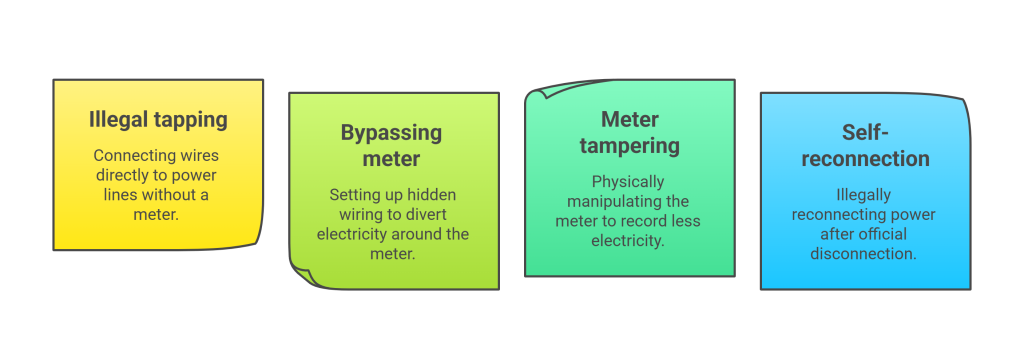
What is illegal tapping (direct theft)?
You might think every home is legally connected to the grid through proper channels, right? Well, that’s not always the case. In fact, illegal tapping happens more often than you’d imagine, especially in areas where people can’t afford to pay for electricity, live in unauthorized settlements, or simply don’t want to deal with the hassle of legal connections.
Illegal tapping occurs when a home or building is not connected to the grid legally at all. Instead of applying for an official connection (which would require a meter to measure usage), people directly hook up their own wires to the main power lines.
📢 Illegal tapping means using electricity without a meter—completely off the grid’s radar.
Think of it like trying to watch a movie at the cinema without buying a ticket. Instead of going through the front door, you sneak in through a side window. You’re still enjoying the movie, but you’ve completely avoided the system meant to track and charge you.
How does it work? ⚡
- Find the source: People locate a power line—either on a pole or underground—that carries electricity from the grid.
- Hook the wire: They connect their own wire directly to this power line, tapping into the flow of electricity.
- Run it home: The other end of the wire runs straight into their house, powering everything from lights and TVs to large appliances like air conditioners and boilers.
- No meter, no record: Since this setup completely avoids the meter, the electricity company has no idea how much power is being used—or even that it’s being used at all.
📢 No meter means no record. No record means no bill.
Where does this happen? 🌍
Illegal tapping is common in:
- Informal settlements where there’s no official grid infrastructure.
- Remote areas where legal connections are expensive or unavailable.
- Urban areas where people want to avoid high electricity bills.
You’d be surprised how widespread it is—even in big cities, there are hidden networks of illegal connections snaking through buildings.
⚠️ Why is it dangerous? ⚠️
- Extreme fire risk: These DIY setups often use poor-quality wires, with no safety standards. Overloaded wires can heat up and cause fires.
- Electrocution hazard: Power lines carry thousands of volts. One wrong move can be fatal—not just for the person doing the tapping, but for anyone nearby.
- Power outages: Illegal connections can overload the grid, causing blackouts for entire neighborhoods.
- No safety mechanisms: Without circuit breakers or fuses, there’s nothing to stop the flow of electricity if something goes wrong.
Real-life example: 🏠⚡
In some overcrowded neighborhoods, you’ll see a web of tangled wires hanging from power poles. Each wire belongs to someone tapping directly into the grid. These chaotic setups not only pose risks to the people stealing power but also to the entire community—one spark can lead to a devastating fire.
The bottom line: 🚨
Illegal tapping isn’t just about stealing electricity—it’s about putting lives at risk. While it might seem like a quick way to get free power, the consequences can be catastrophic for both individuals and entire communities.
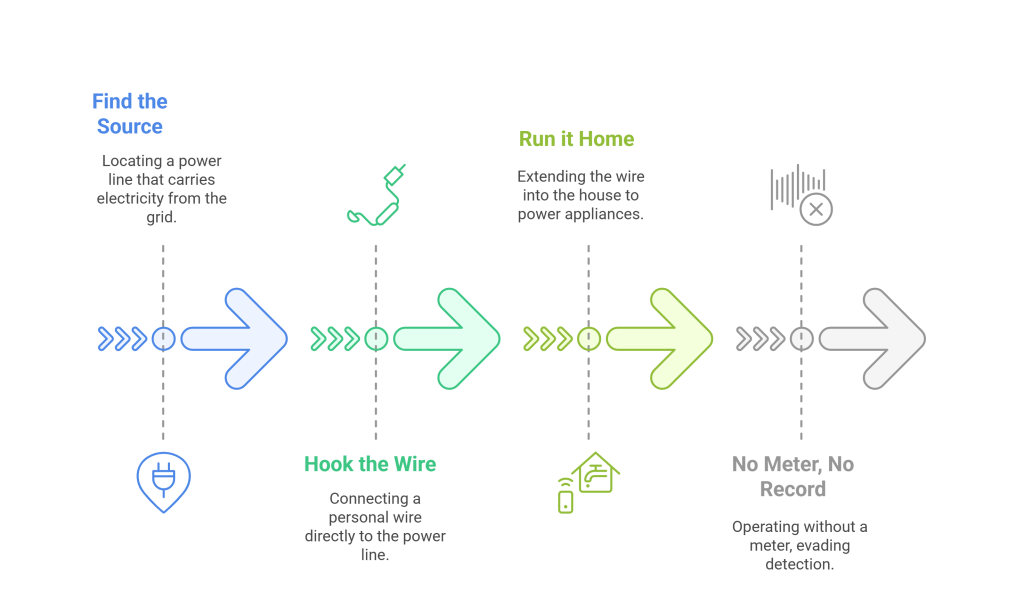
What is bypassing the meter?
When it comes to electricity theft, not everyone relies on risky, illegal taps from power lines. In many cases, people already have legal connections to the grid, complete with a meter installed by the utility company. But here’s the trick: they don’t rely solely on that meter. Instead, they set up hidden wiring that intentionally bypasses the meter altogether.
📢 The meter is there, but it’s not seeing everything.
Think of it like this: you’ve paid for a buffet, but you also sneak food in from the outside to avoid paying for certain dishes. You’re inside legally, but you’re still cheating the system.
Bypassing the meter happens when someone with a legal connection installs extra wires that divert some of the electricity flow around the meter.
- The legal connection is still there. The meter still records some of the electricity being used.
- But there’s a hidden pathway—an extra wire—that allows electricity to flow into the home without being measured.
So, when the bill comes, it looks like they’ve used a small, reasonable amount of power. But in reality, they’re running things like air conditioners, heaters, boilers, or even industrial equipment without the meter counting it.
How does it work? ⚡
- Legal connection: The house or business is connected to the grid with an official meter tracking usage.
- Hidden bypass wires: Someone installs extra wires that “jump over” the meter, creating a secret pathway for electricity to flow without being recorded.
- Double supply: Part of the home’s power comes through the meter (this part gets billed), while the other part flows through the bypass (this part is free and undetected).
- Fake low bills: The power company sees normal meter readings, but they have no idea how much “invisible” electricity is being stolen.
📢 The meter shows a small bill, but behind the scenes, the power is flowing freely.
Where does this happen? 🏠🏭
- In homes: To secretly power high-consumption devices like heaters, water boilers, or air conditioners without paying for the extra energy.
- In businesses: Factories or shops might bypass the meter to run heavy machinery without it reflecting on their electricity bill.
- In rental properties: Landlords might steal electricity for shared spaces while tenants unknowingly cover part of the costs.
⚠️ Why is it dangerous? ⚠️
- Fire risk: These bypass wires are often poorly installed, hidden inside walls, floors, or ceilings—creating hidden fire hazards.
- Overloaded circuits: Because the system isn’t designed to handle unmonitored loads, there’s a higher chance of electrical overloads, which can cause fires or damage appliances.
- Electric shock risk: Faulty wiring increases the risk of electrocution, especially during repairs when electricians don’t expect live wires in certain places.
- Legal trouble: Unlike illegal tapping, which is often hard to detect immediately, bypassing can be uncovered during routine inspections—leading to hefty fines, legal charges, and disconnection.
⚡ Real-life example: 🏢
Imagine a small bakery. The owner pays for electricity legally, but running all those ovens and refrigerators is expensive. So, they secretly install bypass wiring that powers half the equipment without it being recorded.
- The result? Their electricity bill shows modest usage, as if they’re just running a few lights.
- The reality? Industrial ovens are burning 24/7, but no one’s paying for that power.
Eventually, the power company notices that something’s off—maybe through an energy audit or irregular consumption patterns—and the owner gets caught.
📢 Bypassing the meter isn’t about avoiding electricity entirely—it’s about hiding how much you’re really using.
🚨 The bottom line:
Bypassing the meter is like having one foot in the legal world and the other in illegal territory.
- There’s a legal connection, sure.
- But behind the scenes, there’s a hidden setup stealing electricity without the company’s knowledge.
It might seem clever, but it’s risky—not just legally, but for safety, too. Fires, electric shocks, and even criminal charges are just waiting around the corner.
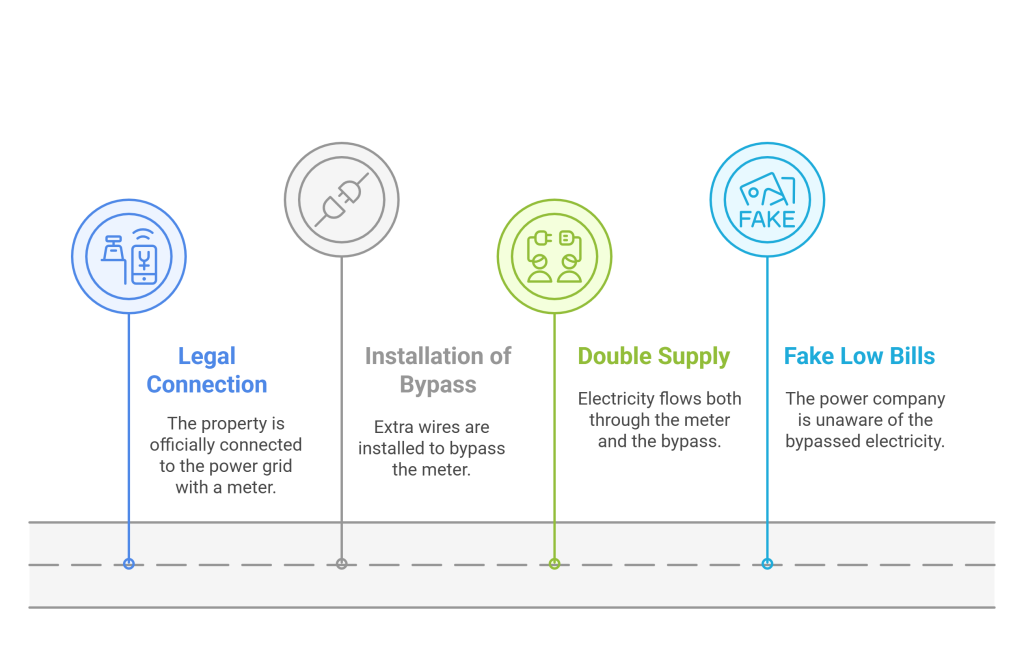
What is meter tampering?
When stealing electricity, some people don’t bother bypassing the meter or hooking up illegal wires. Instead, they take a different route—tampering with the meter itself. The meter stays in place, looks perfectly normal from the outside, but inside? It’s been manipulated to lie about how much electricity is being used.
📢 The meter is still counting—but it’s counting wrong.
Meter tampering is when someone physically interferes with the electricity meter to make it record less electricity than is actually being consumed.
Think of the meter like an odometer in a car, tracking how far you’ve driven. Tampering with the meter is like rolling back the odometer to make it look like the car has fewer miles on it than it really does. The car still runs the same, but the numbers are fake.
With electricity, the goal is simple: make the meter under-report your usage so your bill is much lower than it should be.
How does it work?
People use a variety of tricks to tamper with meters. Some are crude, while others are surprisingly sophisticated:
- Magnet method 🧲:
- What they do: Place a strong magnet on the meter.
- How it works: The magnet disrupts the meter’s internal mechanism, especially in older models with spinning discs, slowing down the recording process.
- Result: The meter spins slower, so it shows less usage than what’s actually being consumed.
- Reversing the meter 🔄:
- What they do: In older analog meters, people can reverse the wiring connections or even flip the meter itself.
- How it works: This makes the meter count backwards, literally reducing the recorded usage over time.
- Result: Your bill goes down, even though you’ve used more electricity.
- Internal tampering 🔧:
- What they do: Open the meter’s casing and manipulate the internal circuits or wiring.
- How it works: This can involve cutting wires, adding jumpers, or altering components that control measurement accuracy.
- Result: The meter keeps running, but it only records a fraction of the actual consumption.
- Remote control hacks 📡:
- What they do: In some advanced cases, especially with smart meters, people install hidden devices or software hacks that allow them to control the meter remotely.
- How it works: They can turn the meter’s tracking function on and off with a remote control or even through an app.
- Result: The meter looks like it’s working fine, but it’s actually recording data inconsistently.
📢 The idea isn’t to stop the meter—it’s to trick it into thinking you’re using less power.
Why do people tamper with meters? 💡
- Lower bills: The obvious reason—to pay less for electricity while using as much as they want.
- Harder to detect: Unlike illegal tapping or bypassing, the connection to the grid remains untouched. From the outside, everything looks normal, making it harder for utility companies to spot the theft without a detailed inspection.
⚠️ Why is it dangerous? ⚠️
- Fire hazards: Messing with the meter’s internal wiring can lead to short circuits and even electrical fires.
- Electric shock risk: Opening a live meter without proper training can cause severe electric shocks—sometimes fatal.
- Legal trouble: Meter tampering is a criminal offense in most countries, with heavy fines and potential jail time if caught.
⚡ Real-life example: 🏠
In a small grocery store, the owner’s electricity bills are through the roof because of refrigeration units running 24/7. To save money, they place a powerful magnet on the meter. The magnet slows down the meter’s spinning disc, making it record only half the actual consumption.
The result? A huge drop in the electricity bill—without reducing any real energy usage.
📢 From the outside, everything looks normal. But inside, the meter has been turned into a liar.
🚨 The bottom line:
Meter tampering is like hacking the system from the inside. Instead of avoiding the meter, people manipulate it to underreport usage. While it might seem clever, it’s dangerous, illegal, and easily detectable with modern monitoring systems. And when caught, the consequences can be far more costly than the savings.
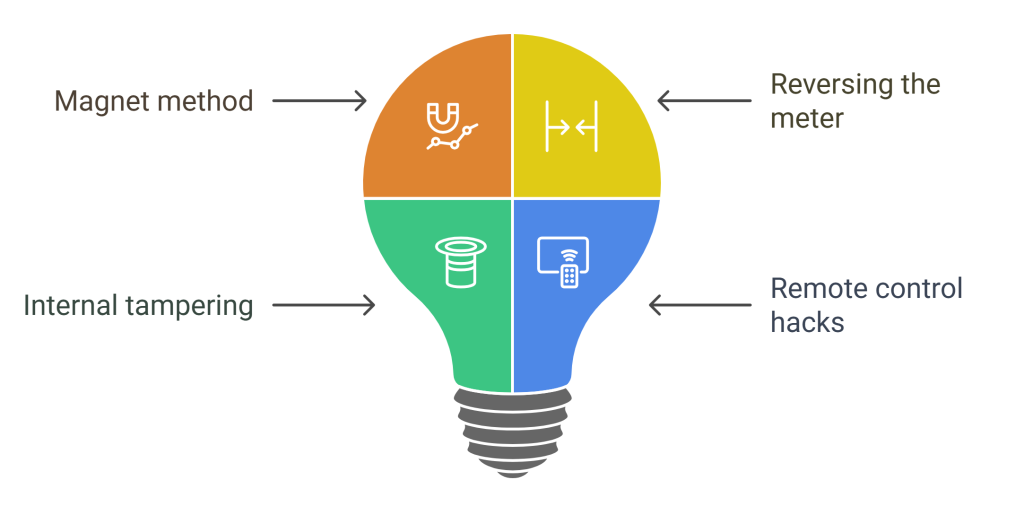
What is self-reconnection?
When someone doesn’t pay their electricity bill, the power company steps in and disconnects their electricity. That’s the rule. But some people don’t accept that. Instead, they decide to reconnect themselves—illegally, of course. This act is known as self-reconnection, and it’s more common than you might think.
📢 Disconnected? No problem—I’ll just reconnect it myself.
Self-reconnection happens when someone’s electricity has been officially disconnected—usually because they didn’t pay their bill—and instead of settling their debt, they illegally restore the connection themselves.
Think of it like being kicked out of a concert for sneaking in without a ticket. Instead of buying a ticket, you just climb over the fence and walk right back in. You’re back inside, but you’re not supposed to be there.
In the case of electricity:
- The power company disconnects the supply due to unpaid bills or violations.
- The person physically reconnects the wires or tampers with the equipment to restore electricity without the company’s permission.
⚡ How does it work?
- The official disconnection:
- The power company cuts off electricity by either removing the fuse, disconnecting cables, or using a lockout device on the meter.
- The illegal reconnection:
- Removing the lock: Some people simply break or remove the lock placed on the meter box.
- Jumping the fuse: Others install jumper wires to bypass the disconnection point, creating a direct path for electricity to flow back into the house.
- Tampering with the service cable: In more extreme cases, they reconnect the main supply wires outside the house, even climbing utility poles to do it.
- Power is back—illegally:
- Electricity flows again, but the person hasn’t paid their debt, and the power company doesn’t know they’ve restored the connection.
📢 It’s like turning the power back on after the company has said, ‘No more.’
Why do people do it? ⚡
- Avoid paying bills: The most common reason—they don’t want to pay what they owe.
- Quick fix: Some people can’t wait for the utility company to officially reconnect them, so they do it themselves.
- False sense of control: There’s a belief that, “If they can turn it off, I can turn it back on.” This leads to risky behavior.
⚠️ Why is it dangerous? ⚠️
- Severe electric shock risk: Tampering with live wires can cause serious injuries or death. High-voltage electricity isn’t forgiving.
- Fire hazards: Improper reconnections often lead to overloaded circuits, increasing the risk of electrical fires.
- Equipment damage: Illegal reconnections can damage not just household appliances but also the broader electrical grid.
- Legal consequences: Self-reconnection is illegal in most countries and can result in heavy fines or criminal charges if caught.
⚡ Real-life example: 🏚️
Imagine someone hasn’t paid their electricity bill for months, and the power company finally comes to disconnect the supply. Frustrated and unwilling to pay, the person waits until nightfall, opens the meter box, and installs a jumper wire that bypasses the disconnection. The lights come back on—but now the connection is illegal and dangerous.
The result? Electricity flows again, but the risk of fire and electrocution skyrockets, and legal trouble is just around the corner.
📢 Just because the lights are back on doesn’t mean everything’s fine. The danger is still there—hidden behind the walls.
🚨 The bottom line:
Self-reconnection is a desperate shortcut with serious consequences. While it might seem like an easy fix to restore power, it’s not just illegal—it’s incredibly dangerous. Electricity isn’t something you can safely “DIY” without proper training. And when the power company discovers the tampering (which they usually do), the penalties can be far worse than just paying the original bill.
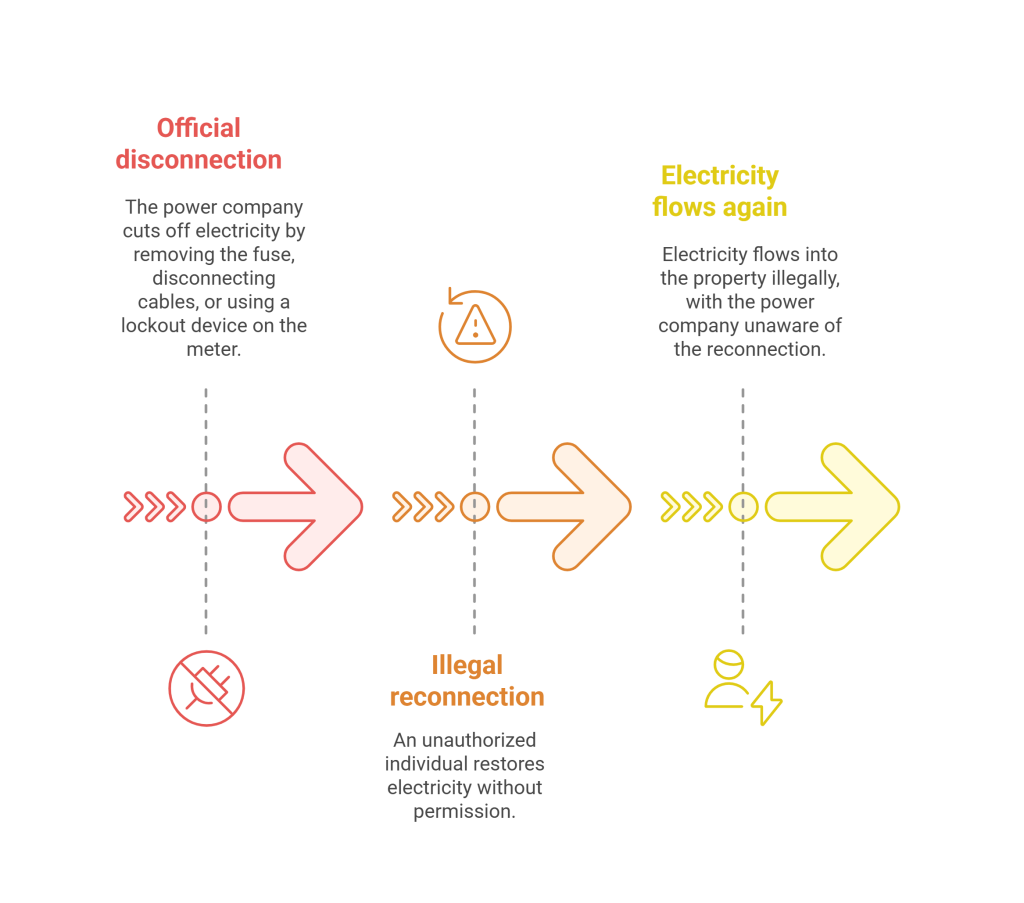
The economic consequences of electricity theft: Who really pays the price?
When people steal electricity, they often convince themselves it’s a victimless crime.
- “I’m just taking from some big, faceless utility company.”
- “The company’s inefficient anyway—they deserve it.”
- “It’s not like I’m hurting anyone.”
But here’s the harsh truth: you’re the one paying for it. Yes, you—the honest customer.
📢 When someone steals electricity, the cost doesn’t disappear—it gets passed on to everyone else.
Why people think it isn’t harmful? 🤔
Many believe that electricity theft is like sneaking an extra donut at an all-you-can-eat buffet. The food’s already there, right? No harm done.
In this case, the buffet is the utility company, seen as a big, inefficient system with plenty of electricity to spare. People feel like they’re “sticking it to the man.” After all, how could one small connection or tampered meter really make a difference?
But here’s the thing: electricity isn’t free to produce, transmit, or maintain. And when someone steals it, the costs don’t magically vanish—they get redistributed to everyone else.
📢 Electricity theft doesn’t hurt the utility as much as it hurts the honest people paying their bills.
How electricity theft affects the economy?
- Higher bills for everyone 💸
- How it happens: Utility companies calculate rates based on how much electricity they generate and distribute. When some of that electricity is stolen, the company still has to cover the costs.
- Who pays? You do. The company raises prices for paying customers to recover the losses. So, every time someone steals power, your bill quietly increases to make up the difference.
- Grid instability ⚡
- How it happens: Illegal connections often overload the system, causing voltage fluctuations, equipment failures, and blackouts.
- Who pays? Businesses lose productivity during outages, and households face inconvenience and damaged appliances. The economy suffers from these disruptions.
- Increased maintenance costs 🛠️
- How it happens: Faulty, illegal connections damage the infrastructure. Utility companies spend more on repairs, inspections, and anti-theft measures.
- Who pays? Again—you do. These costs are factored into electricity rates, pushing prices higher for law-abiding customers.
- Reduced investment in improvements 📉
- How it happens: Utilities rely on revenue from customers to invest in better infrastructure, renewable energy projects, and modern technologies.
- Who pays? When theft drains resources, there’s less money for upgrades, meaning slower improvements in service quality and energy efficiency for everyone.
📢 Every stolen kilowatt is paid for—not by the thief, but by their neighbors.
The ripple effect on society 🌍
Electricity theft isn’t just about individual costs—it has broader economic consequences:
- Strained public services: In many regions, public institutions like schools, hospitals, and street lighting rely on the same grid. Theft leads to power shortages, affecting critical services that everyone depends on.
- Lost tax revenue: Utility companies contribute taxes based on their revenue. When theft reduces profits, governments collect less tax money—meaning less funding for public programs.
- Encouraging a culture of dishonesty: When people see others getting away with theft, it erodes trust in the system and encourages more rule-breaking.
⚡ Real-life example: 🏙️
In some large cities, electricity theft accounts for up to 20% of all power consumed. Utility companies lose millions of dollars every year because of illegal taps and meter tampering. To recover, they raise electricity rates for paying customers.
The result?
- Honest households struggle with higher bills.
- Businesses face increased operating costs, leading to higher prices for goods and services.
- The entire community suffers, not the thieves.
📢 When theft becomes ‘normal,’ everyone pays—except the thief.
🚨 The bottom line:
Electricity theft isn’t sticking it to a big corporation. It’s sticking it to your neighbor, your family, and even yourself.
- Higher bills, more blackouts, and reduced services—all because someone didn’t want to pay their fair share.
- The utility company won’t go bankrupt from theft, but you’ll feel the impact in your wallet every month.
So, the next time someone says, “It’s just a little electricity,” remember: there’s no such thing as free power—someone always pays for it.
How widespread is electricity theft?
Electricity theft isn’t just a local problem—it’s a global issue affecting countries of all sizes, from bustling cities to remote villages. In fact, it’s so common that the World Bank estimates that electricity theft accounts for around 5% to 15% of all electricity distributed worldwide. In some countries, this number skyrockets to over 30% in certain regions.
📢 Electricity theft happens everywhere—from crowded city blocks to quiet rural areas.
Where is it most common?
- Developing countries: In areas where electricity is expensive, incomes are low, or infrastructure is poorly regulated, theft can be rampant. Some neighborhoods even run entirely on stolen power.
- Urban centers: Even in wealthy cities, businesses and households tamper with meters or bypass them to cut costs.
- Industrial zones: Factories and large facilities often steal large amounts of electricity to save on massive energy bills.
⚡ The global impact:
Electricity theft costs the global economy billions of dollars each year, causing financial losses for utilities, higher prices for honest customers, and increased risks of blackouts and accidents.
So, whether it’s through illegal taps, meter tampering, or self-reconnection—electricity theft is everywhere.
Final thoughts
Electricity theft might seem like a distant problem—something that happens in far-off places or shady corners of cities. But the truth is, its effects ripple across the world, reaching right into your home.
From rising electricity bills to life-threatening hazards like fires and electrocution, power piracy is an issue that affects everyone. It drains resources, destabilizes power grids, and shifts the financial burden onto honest, paying customers. It’s not just about lost revenue; it’s about safety, fairness, and the future of sustainable energy.
📢 Electricity theft isn’t just stealing power—it’s stealing from communities, from economies, and from you.
⚡ Let’s juice up this conversation! ⚡
I’ve got some burning questions to spark electrifying debates in the comments:
- Have you ever witnessed electricity theft in your community or workplace? What happened?
- Is electricity theft ever justified? Think about extreme situations—no access to power, life-or-death emergencies.
- Do you think electricity theft is more about survival, greed, or something else entirely?
- Would you report someone you knew was stealing electricity? Or would you turn a blind eye?
- How do you feel knowing that electricity theft could be the reason your bills are higher?
- Is it just theft—or a symptom of bigger social and economic problems?
💬 Join the debate!
Drop your thoughts in the comments below.
Share your stories, your hot takes, your “what would you do?” moments.
Let’s get the sparks flying—challenge ideas, question assumptions, and let’s light up this discussion together.Until next time, stay curious—and stay connected (legally, of course!). 🚀


[…] are way too trusting. Stick a magnet near one, and you can mess with the readings. That’s right: magnetic tampering is a real […]